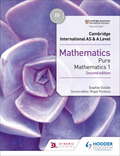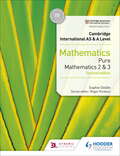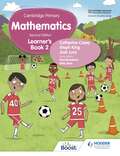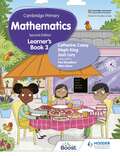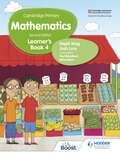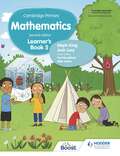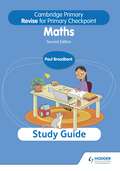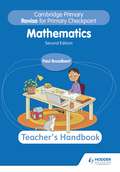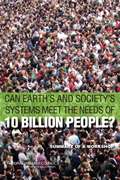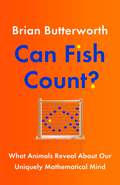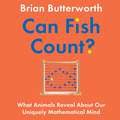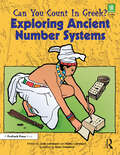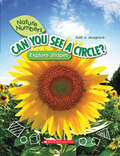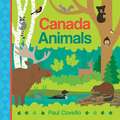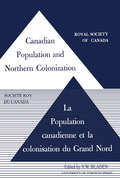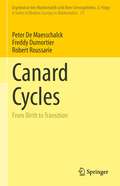- Table View
- List View
Cambridge International AS & A Level Mathematics Pure Mathematics 1 second edition
by Sophie GoldieExam board: Cambridge Assessment International EducationLevel: A-levelSubject: MathematicsFirst teaching: September 2018First exams: Summer 2020Endorsed by Cambridge Assessment International Education to provide full support for Paper 1 of the syllabus for examination from 2020.Take mathematical understanding to the next level with this accessible series, written by experienced authors, examiners and teachers.- Improve confidence as a mathematician with clear explanations, worked examples, diverse activities and engaging discussion points. - Advance problem-solving, interpretation and communication skills through a wealth of questions that promote higher-order thinking. - Prepare for further study or life beyond the classroom by applying mathematics to other subjects and modelling real-world situations.- Reinforce learning with opportunities for digital practice via links to the Mathematics in Education and Industry's (MEI) Integral platform in the eTextbooks.**To have full access to the eTextbooks and Integral resources you must be subscribed to both Dynamic Learning and Integral. To trial our eTextbooks and/or subscribe to Dynamic Learning, visit: www.hoddereducation.co.uk/dynamic-learning; to view samples of the Integral resources and/or subscribe to Integral, visit integralmaths.org/internationalPlease note that the Integral resources have not been through the Cambridge International endorsement process. This book covers the syllabus content for Pure Mathematics 1, including quadratics, functions, coordinate geometry, circular measure, trigonometry, series, differentiation and integration.Available in this series:Five textbooks fully covering the latest Cambridge International AS & A Level Mathematics syllabus (9709) are accompanied by a Workbook, and Student and Whiteboard eTextbooks.Pure Mathematics 1: Student Textbook (ISBN 9781510421721), Student eTextbook (ISBN 9781510420762), Whiteboard eTextbook (ISBN 9781510420779), Workbook (ISBN 9781510421844)Pure Mathematics 2 and 3: Student Textbook (ISBN 9781510421738), Student eTextbook (ISBN 9781510420854), Whiteboard eTextbook (ISBN 9781510420878), Workbook (ISBN 9781510421851)Mechanics: Student Textbook (ISBN 9781510421745), Student eTextbook (ISBN 9781510420953), Whiteboard eTextbook (ISBN 9781510420977), Workbook (ISBN 9781510421837)Probability & Statistics 1: Student Textbook (ISBN 9781510421752), Student eTextbook (ISBN 9781510421066), Whiteboard eTextbook (ISBN 9781510421097), Workbook (ISBN 9781510421875)Probability & Statistics 2: Student Textbook (ISBN 9781510421776), Student eTextbook (ISBN 9781510421158), Whiteboard eTextbook (ISBN 9781510421165), Workbook (9781510421882)
Cambridge International AS & A Level Mathematics Pure Mathematics 2 and 3 second edition
by Sophie GoldieExam board: Cambridge Assessment International EducationLevel: A-levelSubject: MathematicsFirst teaching: September 2018First exams: Summer 2020Endorsed by Cambridge Assessment International Education to provide full support for Paper 2 and 3 of the syllabus for examination from 2020.Take mathematical understanding to the next level with this accessible series, written by experienced authors, examiners and teachers.- Improve confidence as a mathematician with clear explanations, worked examples, diverse activities and engaging discussion points. - Advance problem-solving, interpretation and communication skills through a wealth of questions that promote higher-order thinking. - Prepare for further study or life beyond the classroom by applying mathematics to other subjects and modelling real-world situations.- Reinforce learning with opportunities for digital practice via links to the Mathematics in Education and Industry's (MEI) Integral platform in the eBooks.**To have full access to the eBooks and Integral resources you must be subscribed to both Boost and Integral. To trial our eBooks and/or subscribe to Boost, visit: www.hoddereducation.com/Boost; to view samples of the Integral resources and/or subscribe to Integral, visit integralmaths.org/internationalPlease note that the Integral resources have not been through the Cambridge International endorsement process. This book covers the syllabus content for Pure Mathematics 2 and Pure Mathematics 3, including algebra, logarithmic and exponential functions, trigonometry, differentiation, integration, numerical solution of equations, vectors, differential equations and complex numbers.
Cambridge Primary Mathematics Learner's Book 1 Second Edition
by Catherine Casey Steph King Josh LuryThis title has been endorsed by Cambridge Assessment International Education Master the essential mathematical skills that underpin the new Cambridge Primary Mathematics curriculum framework (0096), with specifically sign-posted tasks and activities rooted in the mastery approach. - Get learners thinking mathematically with engaging activities designed to focus on key skills and principles. - Embed knowledge across all areas of learning, enabling learners to make connections between different areas of mathematics. - Develop vocabulary with probing questions designed to encourage learners to use accurate language to describe how they solve particular problems. <P><P><i>Advisory: Bookshare has learned that this book offers only partial accessibility. We have kept it in the collection because it is useful for some of our members. Benetech is actively working on projects to improve accessibility issues such as these.</i>
Cambridge Primary Mathematics Learner's Book 2 Second Edition
by Catherine Casey Steph King Josh LuryThis title has been endorsed by Cambridge Assessment International Education. Master the essential mathematical skills that underpin the new Cambridge Primary Mathematics curriculum framework (0096), with specifically sign-posted tasks and activities rooted in the mastery approach. - Get learners thinking mathematically with engaging activities designed to focus on key skills and principles. - Embed knowledge across all areas of learning, enabling learners to make connections between different areas of mathematics. - Develop vocabulary with probing questions designed to encourage learners to use accurate language to describe how they solve particular problems.
Cambridge Primary Mathematics Learner's Book 3 Second Edition
by Catherine Casey Steph King Josh LuryThis title has been endorsed by Cambridge Assessment International Education Master the essential mathematical skills that underpin the new Cambridge Primary Mathematics curriculum framework (0096), with specifically sign-posted tasks and activities rooted in the mastery approach. - Get learners thinking mathematically with engaging activities designed to focus on key skills and principles. - Embed knowledge across all areas of learning, enabling learners to make connections between different areas of mathematics. - Develop vocabulary with probing questions designed to encourage learners to use accurate language to describe how they solve particular problems.
Cambridge Primary Mathematics Learner's Book 4 Second Edition
by Steph King Josh LuryThis title has been endorsed by Cambridge Assessment International Education Master the essential mathematical skills that underpin the new Cambridge Primary Mathematics curriculum framework (0096), with specifically sign-posted tasks and activities rooted in the mastery approach. - Get learners thinking mathematically with engaging activities designed to focus on key skills and principles. - Embed knowledge across all areas of learning, enabling learners to make connections between different areas of mathematics. - Develop vocabulary with probing questions designed to encourage learners to use accurate language to describe how they solve particular problems.
Cambridge Primary Mathematics Learner's Book 5 Second Edition
by Steph King Josh LuryThis title has been endorsed by Cambridge Assessment International Education. Master the essential mathematical skills that underpin the new Cambridge Primary Mathematics curriculum framework (0096), with specifically sign-posted tasks and activities rooted in the mastery approach. - Get learners thinking mathematically with engaging activities designed to focus on key skills and principles. - Embed knowledge across all areas of learning, enabling learners to make connections between different areas of mathematics. - Develop vocabulary with probing questions designed to encourage learners to use accurate language to describe how they solve particular problems.
Cambridge Primary Mathematics Learner's Book 6 Second Edition
by Steph King Josh LuryThis title has been endorsed by Cambridge Assessment International Education Master the essential mathematical skills that underpin the new Cambridge Primary Mathematics curriculum framework (0096), with specifically sign-posted tasks and activities rooted in the mastery approach. - Get learners thinking mathematically with engaging activities designed to focus on key skills and principles. - Embed knowledge across all areas of learning, enabling learners to make connections between different areas of mathematics. - Develop vocabulary with probing questions designed to encourage learners to use accurate language to describe how they solve particular problems.
Cambridge Primary Revise for Primary Checkpoint Mathematics Study Guide 2nd edition
by Paul BroadbentBuild, reinforce and assess knowledge with additional practice and revision activities.Cambridge Primary Revise for Mathematics covers the strands of the Cambridge Primary Mathematics curriculum framework: Number, Geometry and Measure, Statistics and Probability, with opportunities for Thinking and Working Mathematically embedded throughout.· - Boost confidence and check students' progress with review tests and practice questions. · - Improve technique with a range of engaging activities, worked examples and a list of key vocabulary. · - Consolidate knowledge with key content presented in a manageable and focussed format. · - Reinforce Thinking and Working Mathematically with activities and questions involving reasoning and problem-solving, with a focus on the key characteristics: specialising and generalising, conjecturing and convincing, characterising and classifying and critiquing and improving.Cambridge Primary Revise for Mathematics can be used independently for homework or additional practice, or alongside the Teacher's Guide in the classroom.
Cambridge Primary Revise for Primary Checkpoint Mathematics Teacher's Handbook 2nd edition
by Paul BroadbentFocus revision where learners need most support and ensure coverage of the Cambridge Primary Mathematics curriculum framework with easy-to-follow teaching notes.- Assess knowledge and progress with structured practice tests and whole-class activities.-Improve understanding and technique with photocopiable resources such as model texts, practice questions and games.- Introduce strategies for supporting recall and revision with further ideas to stretch learners and marking guidance.This resource has not been through the Cambridge International endorsement process.
Cambridge Studies in Law and Society: The Quiet Power of Indicators
by Sally Engle MerryUsing a power-knowledge framework, this volume critically investigates how major global indicators of legal governance are produced, disseminated and used, and to what effect. Original case studies include Freedom House's Freedom in the World indicator, the Global Reporting Initiative's structure for measuring and reporting on corporate social responsibility, the World Justice Project's measurement of the rule of law, the World Bank's Doing Business index, the World Bank-supported Worldwide Governance Indicators, the World Bank's Country Performance Institutional Assessment (CPIA), and the Transparency International Corruption (Perceptions) index. Also examined is the use of performance indicators by the European Union for accession countries and by the US Millennium Challenge Corporation in allocating US aid funds.
Cambridge Studies in Nineteenth-Century Literature and Culture: The Demographic Imagination and the Nineteenth-Century City
by Nicholas DalyIn this provocative book, Nicholas Daly tracks the cultural effects of the population explosion of the nineteenth century, the 'demographic transition' to the modern world. As the crowded cities of Paris, London and New York went through similar transformations, a set of shared narratives and images of urban life circulated among them, including fantasies of urban catastrophe, crime dramas, and tales of haunted public transport, refracting the hell that is other people. In the visual arts, sentimental genre pictures appeared that condensed the urban masses into a handful of vulnerable figures: newsboys and flower-girls. At the end of the century, proto-ecological stories emerge about the sprawling city as itself a destroyer. This lively study excavates some of the origins of our own international popular culture, from noir visions of the city as a locus of crime, to utopian images of energy and community.
Cambridge Tracts In Mathematics
by R. M. GreenMinuscule representations occur in a variety of contexts in mathematics and physics. They are typically much easier to understand than representations in general, which means they give rise to relatively easy constructions of algebraic objects such as Lie algebras and Weyl groups. This book describes a combinatorial approach to minuscule representations of Lie algebras using the theory of heaps, which for most practical purposes can be thought of as certain labelled partially ordered sets. This leads to uniform constructions of (most) simple Lie algebras over the complex numbers and their associated Weyl groups, and provides a common framework for various applications. The topics studied include Chevalley bases, permutation groups, weight polytopes and finite geometries. Ideal as a reference, this book is also suitable for students with a background in linear and abstract algebra and topology. Each chapter concludes with historical notes, references to the literature and suggestions for further reading.
Campus Sex Assaults
by Chicago Tribune StaffIn September 2010, St. Mary's College freshman Elizabeth "Lizzy" Seeberg was found dead, a victim of an apparent suicide from prescription medication, mere days after alleging she had been sexually attacked by a Notre Dame football player. Starting in November of that year, the Chicago Tribune began reporting on this case that was up until that point not publicly acknowledged by the University of Notre Dame. Over the course of the next year, Tribune journalists and investigators produced a series of articles focusing on this case--and the cases of other sexual assault victims on Midwestern university campuses7mdash;leading to new investigations and subsequent reforms at schools across the region.Campus Sexual Assaults is a gripping and important piece of investigative journalism, revealing disturbing primary materials from cases and shocking personal interviews with the victims. The yearlong investigation shed light on the antiquated and obfuscated reporting and prosecuting practices of major Midwest colleges and universities, going so far as to discover that Notre Dame campus authorities did not even promptly investigate the alleged assault that occurred days before Lizzy Seeberg's death. Campus Sexual Assaults goes on to investigate similar trends in under-reporting and under-prosecuting sexual assaults on campuses across the country.Part 1 of Campus Sexual Assaults reports on the Seeberg case as it unfolded, and ends with the county prosecutor's decision that there would be no charges, since the victim's death made her statements inadmissible in court. Part 2 has a wider focus, as the Tribune reports on another similar attack at Notre Dame and a survey finding that few people accused of sexual violence on college campuses are ever convicted. Part 3 deals with reforms at Notre Dame and similar problems at Marquette University.The powerful stories told in Campus Sexual Assaults by the survivors and families victimized by these attacks are moving as much as they can be upsetting. After months of reporting and research on the Seeberg case and others like it, the Tribune's investigations sparked new legal investigations and subsequent reforms at the campuses in question. This collection of articles and investigative reports is a touching, in-depth look at an endemic problem at universities across America and should be required reading for not only campus and sexual health educators, but for university audiences and concerned readers everywhere.
Can Earth's and Society's Systems Meet the Needs of 10 Billion People?: Summary of a Workshop
by Maureen MellodyThe Earth's population, currently 7. 2 billion, is expected to rise at a rapid rate over the next 40 years. Current projections state that the Earth will need to support 9. 6 billion people by the year 2050, a figure that climbs to nearly 11 billion by the year 2100. At the same time, most people envision a future Earth with a greater average standard of living than we currently have - and, as a result, greater consumption of our planetary resources. How do we prepare our planet for a future population of 10 billion? How can this population growth be achieved in a manner that is sustainable from an economic, social, and environmental perspective? Can Earth's and Society's Systems Meet the Needs of 10 Billion People? is the summary of a multi-disciplinary workshop convened by the National Academies in October 2013 to explore how to increase the world's population to 10 billion in a sustainable way while simultaneously increasing the well-being and standard of living for that population. This report examines key issues in the science of sustainability that are related to overall human population size, population growth, aging populations, migration toward cities, differential consumption, and land use change, by different subpopulations, as viewed through the lenses of both social and natural science.
Can Fish Count?: What Animals Reveal About Our Uniquely Mathematical Minds
by Brian ButterworthAn entertaining investigation of the numerical abilities of animals and our own appetite for arithmetic The philosopher Bertrand Russell once observed that realizing that a pair of apples and the passage of two days could somehow both be represented by the concept we call &“two&” was one of the most astonishing discoveries anyone had ever made. So what do we make of the incredible fact that animals seem to have inherent mathematical abilities? As cognitive psychologist Brian Butterworth shows us in Can Fish Count?, many &“simple&” animals—such as bees, which count trees and fence posts, and guppies, which can size up groups—have a sense of numbers. And unlike humans, they don&’t need to be taught. In telling animals&’ stories, Butterworth shines new light on one of our most ancient questions: Just where, exactly, do numbers come from? He reveals how insights gleaned from studying animals can help us make better sense of our own abilities. Full of discovery and delight, Can Fish Count? is an astonishing journey through the animal kingdom and the human mind.
Can Fish Count?: What Animals Reveal about our Uniquely Mathematical Mind
by Brian Butterworth'What I like best about this fascinating book is the detail. Brian Butterworth doesn't just tell us stories of animals with numerical abilities: he tells us about the underlying science. Elegantly written and a joy to read' - Professor Ian Stewart, author of What's the Use? and Taming the Infinite'Full of thought-provoking studies and animal observations' - Booklist'Enlightening and entertaining' - Publishers WeeklyThe Hidden Genius of Animals: Every pet owner thinks their own dog, cat, fish or hamster is a genius. What makes CAN FISH COUNT? so exciting is the way it unveils just how widespread intelligence is in nature. Pioneering psychologist Brian Butterworth describes the extraordinary numerical feats of all manner of species ranging from primates and mammals to birds, reptiles, fish and insects. Whether it's lions deciding to fight or flee, frogs competing for mates, bees navigating their way to food sources, fish assessing which shoal to join, or jackdaws counting friends when joining a mob - every species shares an ability to count.Homo Sapiens may think maths is our exclusive domain, but this book shows that every creature shares a deep-seated Darwinian ability to understand the intrinsic language of our universe: mathematics CAN FISH COUNT? is that special sort of science book - a global authority in his field writing an anecdotally-rich and revelatory narrative which changes the way you perceive something we take for granted.
Can Fish Count?: What Animals Reveal about our Uniquely Mathematical Mind
by Brian ButterworthEvery pet owner thinks their own dog, cat, fish or hamster is a genius. What makes CAN FISH COUNT? so exciting is the way it unveils just how widespread intelligence is in nature. Pioneering psychologist Brian Butterworth describes the extraordinary numerical feats of all manner of species ranging from primates and mammals to birds, reptiles, fish and insects. Whether it's lions deciding to fight or flee, frogs competing for mates, bees navigating their way to food sources, fish assessing which shoal to join, or jackdaws counting friends when joining a mob - every species shares an ability to count.Homo Sapiens may think maths is our exclusive domain, but this book shows that every creature shares a deep-seated Darwinian ability to understand the intrinsic language of our universe: mathematics CAN FISH COUNT? is that special sort of science book - a global authority in his field writing an anecdotally-rich and revelatory narrative which changes the way you perceive something we take for granted.(P)2022 Quercus Editions Limited
Can You Count in Greek?: Exploring Ancient Number Systems (Grades 5-8)
by Judy Leimbach Kathy LeimbachDiscovering the way people in ancient cultures conducted their lives is fascinating for young people, and learning how these people counted and calculated is a part of understanding these cultures. This book offers a concise, but thorough, introduction to ancient number systems. Students won't just learn to count like the ancient Greeks; they'll learn about the number systems of the Mayans, Babylonians, Egyptians, and Romans, as well as learning Hindu-Arabic cultures and quinary and binary systems. Symbols and rules regarding the use of the symbols in each number system are introduced and demonstrated with examples. Activity pages provide problems for the students to apply their understanding of each system. Can You Count in Greek? is a great resource for math, as well as a supplement for social studies units on ancient civilizations. This valuable resource builds understanding of place value, number theory, and reasoning. It includes everything you need to easily incorporate these units in math or social studies classes. Whether you use all of the units or a select few, your students will gain a better understanding and appreciation of our number system.Grades 5-8
Can You Count to a Googol?
by Robert E WellsYou may be able to count all the way to one hundred, but have you ever counted to a googol? It's impossible! In this fun book of numbers, Robert E. Wells explores the wonderful world of zeros and tells how the googol came to be named.
Can You See a Circle?: Explore Shapes (Nature Numbers)
by Ruth MusgraveIn Nature Numbers, math is beautiful, recognizable, and all around us! Highly engaging pictures of animals and nature scenes, along with cool chalk illustrations, are used to introduce basic math concepts and encourage kids to see a world of numbers all around them.K-2 math concepts include learning about shapes. This book explores shapes in nature with amazing nature pictures and chalk illustrations!
Can You Solve My Problems?: Ingenious, Perplexing, And Totally Satisfying Math And Logic Puzzles (Alex Bellos Puzzle Books #0)
by Alex BellosPuzzle lovers, rejoice! Bestselling math writer Alex Bellos has a challenge for you: 125 of the world’s best brainteasers from the last two millennia. Armed with logic alone, you’ll detect counterfeit coins, navigate river crossings, and untangle family trees. Then—with just a dash of high school math—you’ll tie a rope around the Earth, match wits with a cryptic wizard, and use four 4s to create every number from 1 to 50. (It can be done!) The ultimate casebook for daring puzzlers, Can You Solve My Problems? also tells the story of the puzzle—from ancient China to Victorian England to modern-day Japan. Grab your pencil and get puzzling!
Canada Animals
by Paul CovelloThe latest title in Paul Covello’s winning Canada board-book series features wondrously detailed illustrations for the very young, highlighting some of Canada’s most beloved and iconic creatures. From the author and illustrator of the national bestsellers Canada ABC and Canada 123.
Canadian Population and Northern Colonization/La Population canadienne et al colonisation du Grand Nord: Symposium presented to the Royal Society of Canada/Colloque presente a la Societe Royale du Canada (Royal Society of Canada Studia Varia Series #no. 8)
by V. W. BladenIn their annual sessions the various Sections of the Royal Society are accustomed to take up for general discussion a topic of current interest and this gives Fellows and special guests from the natural sciences, the social sciences, and the humanities an opportunity for useful communication across the disciplines on an important subject.<P><P>In 1961 the topic was an especially vital issue, the population explosion, and this volume, based on the papers given at the meeting, has much valuable information and many pertinent and provocative comments on this phenomenon particularly as it affects Canada.<P>T.W.M. Cameron leads off with a general background on the causes and consequences of the population increase around the world. Then come a group of papers presenting various aspects of the population in Canada's settled areas. Pierre Dagenais studies the growth in that population in recent years; Guy Rocher presents developments in our labour force in the 1900's with particular reference to the older age group, to women, and to the unemployed; Jacques Henripin describes ethnic and linguistic patterns over the country; Nathan Keyfitz outlines new patterns in the birth rate and their significance. A.R.M. Lower concludes this portion of the book with a lively historical study of the effects of natural increase and waves of immigration in the French and English periods, leading on to our present "bold experiment" in Canada which assumes the "risks of a non-homogeneous, non-integral society with every value fighting it out for survival."<P>The second part of the book turns to those largely unsettled areas stretching away in Canada's north and considers the potentialities of these areas as a more permanent habitat for man. With an introduction by René Pomerleau, various problems of settlement are brought forward. W. Keith Buck and D.J.F. Henderson discuss economic aspects of mineral development in the north; E.W. Humphrys, the possible use of atomic energy as a way of coping with fuel and supply; M.J. Dunbar, the prospects of support for a new population in the use natural resources contributed by the land and the sea; G. Malcolm Brown, problems of man's acclimatization to life in a colder climate; Trevor Lloyd, the kind of settlement in the Far North which is desirable and possible given its special conditions of subsistence and transportation and economic activity. All these authors stress that any planning for a northern future "must be based on a broad, systematic and thorough scientific appraisal."<P>This is an important and absorbing book and it will give both specialist and general reader much to think about.
Canard Cycles: From Birth to Transition (Ergebnisse der Mathematik und ihrer Grenzgebiete. 3. Folge / A Series of Modern Surveys in Mathematics #73)
by Freddy Dumortier Robert Roussarie Peter De MaesschalckThis book offers the first systematic account of canard cycles, an intriguing phenomenon in the study of ordinary differential equations. The canard cycles are treated in the general context of slow-fast families of two-dimensional vector fields. The central question of controlling the limit cycles is addressed in detail and strong results are presented with complete proofs.In particular, the book provides a detailed study of the structure of the transitions near the critical set of non-isolated singularities. This leads to precise results on the limit cycles and their bifurcations, including the so-called canard phenomenon and canard explosion. The book also provides a solid basis for the use of asymptotic techniques. It gives a clear understanding of notions like inner and outer solutions, describing their relation and precise structure.The first part of the book provides a thorough introduction to slow-fast systems, suitable for graduate students. The second and third parts will be of interest to both pure mathematicians working on theoretical questions such as Hilbert's 16th problem, as well as to a wide range of applied mathematicians looking for a detailed understanding of two-scale models found in electrical circuits, population dynamics, ecological models, cellular (FitzHugh–Nagumo) models, epidemiological models, chemical reactions, mechanical oscillators with friction, climate models, and many other models with tipping points.
